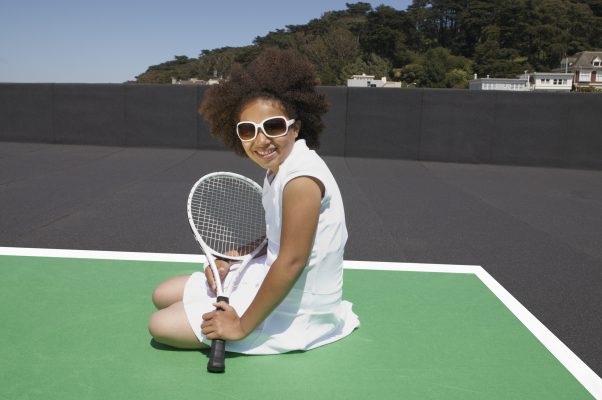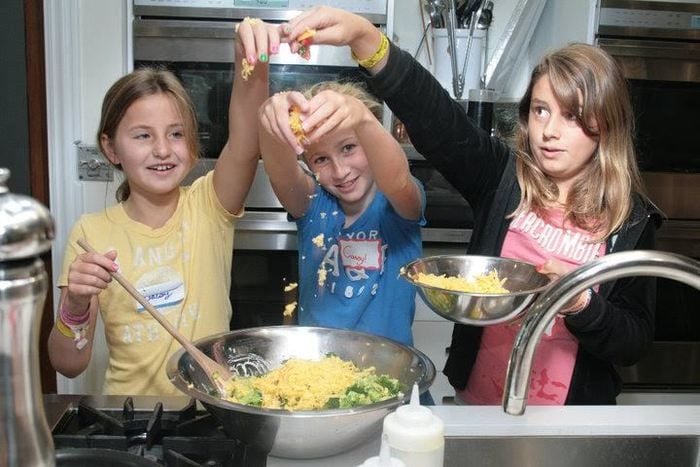Here’s a roundup of everything you need to know about tennis for kids before your’s picks up a racket.
- Get the Right Equipment/Clothing
Clothing: Comfort is the main concern when selecting what to wear. Any sports clothes will work as long as your kid can move freely/easily.
Footwear: Any tennis shoes your kid is comfortable with. However, running shoes should be avoided since they don’t support the sudden changes in direction that you make while playing the game.
Racket: The tennis racket has definitely changed over the years. No more wood! Now, there are many styles available and all sorts of string types. When kids are playing the game, you want to make sure the racket is a size appropriate for them. Many manufacturers make rackets specifically tailored to a child’s age and height. Guidelines are as follows:
AGE HEIGHT RACKET SIZE
5 yrs. or less 44” or less 19” or 21”
6-8 yrs. 45”-49” 23”
8-10 yrs. 50”-55” 25”
10 yrs. or older 55” or taller 26”
You’ll want to make sure a racket with the right grip size is being used. To test: when your kid holds the handle, there should be a 1cm gap between your thumb and index finger. As far as the racket type and string type, try a few out. See what is most comfortable. Oversize and heavier rackets typically provide more power while smaller heads tend to give more control.
The Ball: You probably never thought about this one before, huh? But, there are actually several different varieties. Here’s a good guide for what to use when starting out:
-Ages 4-6: Use foam tennis balls with high density foam
-Ages 6-8: Use low compression balls at 50%
-Ages 10 and older: Use low compression balls at 75%
-Adults: When learning, start off with a low compression ball and once comfortable, switch to a regular ball.
2. Know the Rules of the Game
1. Tennis is played on a rectangular court, 78 ft. long and 27 ft. wide (for singles) or 36 ft. wide (for doubles) with a net running across the center of the court.
2. The object of the game is to hit the ball over the net into your opponent’s court while keeping the ball within the margins of the court. You gain points each time your opponent is unable to return a ball that you landed within those guidelines.
3. Play can consist of one person on each side of the net (singles) or, a team of two people on each side of the net (doubles).
4. To start the game, a coin toss is performed. The winner of the coin toss can either decide to serve or, decide which side of the court to start on.
5. The serve takes place behind the baseline, starting at the right hand corner and alternating right side, then left side for each point. The ball is always served cross-court (diagonally) into the opponent’s service box. The score is announced prior to each ball served. The server’s feet must remain behind the baseline until the service is complete or they are subject to a foot fault. If a server hits the net and the ball bounces inside the service box, this is called a let and they are allowed to serve again. If the ball hits the net and bounces outside of the service box, that is a fault. Two faults and the opponent wins the point. In the case of a doubles game, service is shared by the two players of each team alternately and changed between the opposing team after every game (each player will serve every 4th game). The receiver may stand wherever they wish to return the serve. But, on the serve, the ball must bounce once. If it is returned without a bounce, then the server will receive the point. If a serve is good but the opponent fails to hit it, the server will receive the point (this is called an ace).
6. If the serve is good, play continues until a player fails to return the ball, the ball bounces twice or a player calls a ball “out”. The ball is allowed to hit any part of the baseline or sideline to be “in” during play, if the ball bounces outside of the baseline or sideline, the ball is “out”. The baseline is the line furthest back on each side of the court and the inner sideline is for singles with the outer sideline being for doubles.
7. The player who scores 4 points first wins, as long as there is a difference of two points in the score. Win 6 games to win a set.
8. Remember: Always respect your fellow players.
Learning a Good Grip
Forehand
The easiest grip for learning the forehand is the Eastern Forehand Grip. To use the Semi-Western Forehand Grip, the index knuckle and heel pad should rest on bevel 4. And, for the Western Forehand Grip, the index knuckle and heel pad reside on bevel 5.hand is the Eastern Forehand Grip. To execute this grip, pretend you are going to shake hands with the racket. You could also follow the illustration above and place your index knuckle and heel pad on bevel 3. Some other grips include the Continental Grip, the Semi-Western Forehand Grip and the Western Forehand Grip. For the Continental Grip, the index knuckle and heel pad should rest on bevel 2. This grip is popular for serving the b
Backhand
Some players prefer to use two hands for their backhand. To execute a Two Handed Backhand Grip, the right hand will be at the bottom of the grip with the index knuckle at bevel 2 and the heel pad at bevel 1. The left hand will be higher on the grip and the index knuckle and heel pad will rest at bevel 7. An Eastern Backhand Grip is done by placing the index knuckle and heel pad at bevel 1.
3. Learn to Volley
The volley takes place near the net. It can be risky to come forward and leave the court behind you open. But, it can also mean a point for you if you do it right. You want to be in a ready position; facing forward, knees slightly bent and your racket held in front of you with both hands and your grip in place.
-Move your elbows forward so they are just in front of your body.
-When you see the ball coming, move your head and hands toward the ball.
-Do not swing at the ball but rather, the shot should be short and choppy.
-Use your wrist and forearm to bring the racket head down on the ball in a sharp action.
-Follow through in the direction you would like the ball to go.
4. Explore the Different Types of Tennis Shots
In addition to the volley, here are some tennis shots to get you started:
The Serve: This is the shot that starts the game. It is carried out by throwing the ball up in the air and hitting it at its peak height. Remember, your feet need to stay behind the baseline until the serve is complete. Start serving on the right hand side of the court and serve diagonally into the opponent’s service box.
The Lob: This is when you return a ball that goes very high in the air, usually out of reach of your opponent.
The Drop Shot: When your opponent is playing the baseline, you can try this trick. Hit the ball just enough to go over the net and bounce in. Your opponent rarely has time to get to the ball before it bounces twice. Be careful though, if the ball doesn’t make it over the net, you opponent wins the point.
The Backhand Shot: This is when you swing the racket from the opposite side of your strong hand. Some use two hands for this shot. The backhand is essential for when you can’t make it to the ball using your forehand.
The Forehand Shot: The easiest and what you will use the most. Just swing the racket away from your body on the same side in which you hold your racket. Always step into the shot and follow completely through with your swing.
Slice: A slice can be used when serving or during a forehand or backhand shot. A slice shot is hit by brushing underneath the tennis ball and creating backspin.
5. Understand Scoring
When starting the game, each player has 0 (referred to as LOVE).
1 point = 15
2 points = 30
3 points = 40
4 points = Game
If both players (or teams) reach 40 (and the score is tied), a deuce will take place. In order to win, a player or team must win both points consecutively. A deuce is served on the right hand side of the court. If the server wins the point, he or she then serves from the left hand side of the court and has advantage (ad-in). If he/she wins that point, they will win the game. But, if they lose the point it goes back to a deuce. This continues until the deuce and advantage points are both won by the same person/team.
SETS- A set is completed when one of the players wins 6 games by a margin of two or more games.
MATCHES- Matches are played in several different ways depending on the players and the setting. The best 2 out of 3 sets is the most common.
6. Remember to Have Fun
Tennis is a great sport and provides exercise and excitement. But, the most important thing is to have fun. Tennis involves a lot of rules and regulations. Here are a couple of games that still have you learning about the game but are a little less rigid.
The Bucket Game: To set up, place 5 buckets on each side of the court. Players stand on the baseline. The first player tries to hit 20 balls into any of the buckets on the other side of the net. If a ball doesn’t make it over the net, the other player will add it to their ball count. The other player then does the same thing. After all balls are hit, each player collects the balls not in the buckets on his/her side of the net and tries again. Play continues until all balls are in the buckets. Whoever makes the most shots wins.
The School Game: Players start at the service line and try to serve into the service box. Once he/she gets three serves into both service boxes, the player will graduate from Kindergarten to Grade School. Now, do the same thing but 4 ft. from the service line (Grade School). Then, 12 ft. from the service line (High School). When a player is able to serve from behind the baseline, they have graduated!
Looking for some tennis camps? Here’s a few ideas.
















